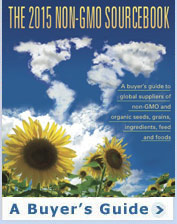Vitamins present GMO challenges for organic industry
Genetically modified microorganisms are increasingly used to manufacture vitamins, enzymes, flavors, and other food additives. These products present challenges to organic processors who want to avoid using GM ingredients and to organic certifiers who must interpret vague GMO prohibition rules to prohibit their use.
GM microorganisms are replacing chemical, synthetic methods to produce vitamins, flavors, enzymes, and other food additives. Proponents say GM microorganisms are easy to cultivate, don’t require harsh chemicals, are environmentally friendly, and use less energy.
To produce a food additive such as a vitamin, genetic engineers will indentify a microorganism that can produce the additive, such as a bacteria or fungi, and genetically alter it. The GM microorganism is then placed in fermenters, closed stainless steel tanks that are used to create conditions where the microorganism can thrive and produce the desired product in large quantities. When the growth and production is complete, the vitamin is isolated and purified. Proponents say that no traces of microorganisms are present in the final product, and no GM DNA is detectable.
GM microorganisms are used to make vitamin B2 (riboflavin), vitamin C (ascorbic acid), xanthan (a thickener), citric acid, and enzymes used in cheeses, breads and baked goods, alcoholic beverages, and juice.
While proponents say production of GM microorganisms is safe, there has been one major catastrophe. In 1989, an L-tryptophan food supplement, produced using a genetically engineered microorganism, was responsible for the deaths of 37 people and disabling of several thousand more in the United States.
GMO concerns
According to the National Organic Program, vitamins are non-agricultural, synthetic substances that are allowed as ingredients in organic food processing. Organic food processors commonly fortify cereals and beverages with vitamins E and B.
Organic processors face GMO challenges with vitamins, says Brian Baker, research director, Organic Materials Review Institute (OMRI). “More and more vitamins are coming from genetically modified sources.”
Vitamins E (tocopherols) and C are the most common vitamins raising GMO concerns, since E is derived from soy and C from corn. But Baker believes that both B2 and B12 (cyanocobalamin) are now primarily derived from GM microorganisms. Meanwhile, biotechnology companies have received patents in recent years to produce other vitamins, such as A (betacarotene) and C, from GM microorganisms.
A few years ago, Baker warned the National Organic Standards Board (NOSB) about increasing GMO risks with vitamins in a letter, stating, “The NOSB should be aware that a growing number of vitamins are produced using genetically engineered organisms, making it ever more necessary to develop natural and from organically produced and non-synthetic sources.”
Inconsistent interpretation of GMO ban
According to Gwendolyn Wyard, processing program reviewer at organic certifier Oregon Tilth, the use of B vitamins creates challenges for organic food companies and for organic certifiers.
The NOP rule states that an organic product “must be produced and handled without the use of excluded methods,” such as genetic engineering.
The problem, says Wyard, is that the language in the NOP regarding excluded methods is ambiguous. “This has led to inconsistent interpretations of the GMO prohibition by organic certifiers,” she says.
“An organic processor putting a GM-derived vitamin in their product could say ‘I have handled a product without the use of an excluded method,’” she says.
The processor may have also received a statement from the vitamin supplier saying that GM DNA is not detectable in the vitamin.
One organic certifier may allow the GM-derived vitamin to be used because the processor did not use an excluded method even though the vitamin is a product of genetic engineering, an excluded method, and contains no detectable GM DNA. Another certifier would focus on the fact that the vitamin was produced using an excluded method and therefore should be prohibited in a product labeled organic.
OMRI and Oregon Tilth favor the latter interpretation. “We look at the microorganism,” Wyard says.
There is precedence for this interpretation. The NOSB has ruled that rennet derived from a GM microorganism, chymosin, is prohibited in organic processing.
Wyard calls the inconsistent interpretation of organic rules on vitamins a “big can of worms” that organic certifiers need to solve amongst themselves rather than taking it to the NOSB.
The increasing use of genetic engineering to make vitamins presents challenges for organic processors who have to use non-GMO ingredients. “What happens when you want to use a substance that is on the national list of approved substances, and the only things available are from GMOs?” Wyard asks.
© Copyright The Organic & Non-GMO Report October 2008




